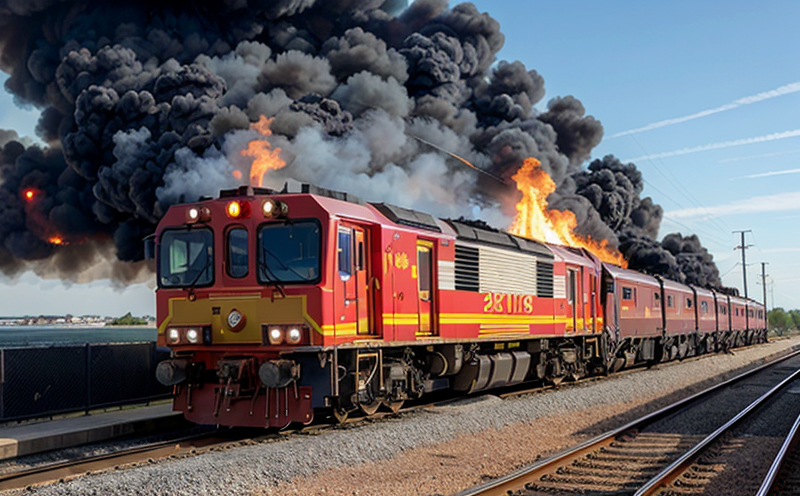Evaluation of Smoke and Flame Propagation in Railway Carriages
The evaluation of smoke and flame propagation in railway carriages is a critical aspect of fire safety testing. This service ensures that railway carriage interiors meet stringent safety standards, preventing the spread of fire and minimizing the risk to passengers and staff.
Smoke and flame propagation tests are conducted to determine how materials within railway carriages perform under real-world conditions. These evaluations help identify potential hazards and ensure compliance with international standards such as ISO, ASTM, EN, and IEC. The objective is to assess whether materials and finishes can withstand exposure to flames without contributing significantly to the spread of smoke or fire.
Our testing facility is equipped with specialized equipment designed specifically for railway applications. This includes a range of test chambers capable of simulating various environmental conditions. Our team of experts uses advanced analytical techniques to measure key parameters such as flame height, smoke density, and heat release rate. These metrics are crucial in determining the performance characteristics of materials used in railway carriages.
Testing is carried out according to internationally recognized standards like ISO 16725 for fire resistance of structural elements, EN 458 for fire resistance of doors, and ASTM E662 for smoke density measurement. These guidelines provide a framework for consistent testing procedures across industries. By adhering strictly to these specifications, we ensure that our clients receive accurate and reliable results.
The process begins by selecting appropriate samples from the materials intended for use in railway carriages. Specimens are then prepared according to specific instructions provided by relevant standards documents. Once ready, they are placed into designated test chambers where controlled burns are initiated under carefully monitored conditions.
Real-world applications of this service extend beyond mere compliance checks; it serves as a valuable tool for product development and improvement efforts within the railway industry. Manufacturers can use insights gained from these tests to refine their designs, selecting more effective fire retardant materials or optimizing existing ones. Additionally, ongoing monitoring allows companies to stay ahead of regulatory changes and market trends.
Our comprehensive approach ensures not only compliance but also enhanced safety levels for passengers traveling on modern railway systems worldwide. By leveraging our expertise in this area, customers can rest assured that their products meet the highest standards of fire safety.
Applied Standards
Scope and Methodology
| Test Parameter | Description |
|---|---|
| Flame Height | The vertical distance from the base of a flame to its highest point. Measured using calibrated instruments. |
| Smoke Density | A quantitative measure indicating how much light is blocked by smoke produced during combustion. Determined through optical densitometry. |
| Heat Release Rate (HRR) | The rate at which heat is released from a material when exposed to fire. Calculated based on temperature measurements over time. |
To conduct these tests, we use state-of-the-art equipment including high-temperature furnaces and smoke densitometers. Specimens are subjected to controlled ignition sources that simulate actual fire scenarios. Throughout the test duration, data is continuously collected and analyzed using sophisticated software tools.
After completion of each evaluation, detailed reports are prepared outlining all findings alongside graphical representations where applicable. These documents serve as valuable resources for stakeholders involved in decision-making processes related to material selection and design optimization.
International Acceptance and Recognition
- The tests conducted here comply with international standards recognized globally by organizations such as ISO, ASTM, EN, and IEC.
- Results obtained from our lab are widely accepted in both developed and developing countries due to their rigorous methodology and adherence to best practices.
This broad acceptance enhances confidence among clients seeking assurance that their products meet the highest safety standards. Furthermore, it facilitates smoother international trade by eliminating discrepancies between different national regulations.





